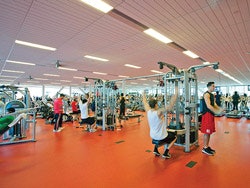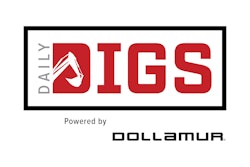The frame of the seated leg curl machine was covered by a lifetime warranty, and when it succumbed to wear and broke the first time, the manufacturer shipped out a new one at no charge. (Not wanting to jeopardize a longtime relationship with this particular vendor, the club owner prefers that all names, personal or company, be withheld.)
 (Photo of California State university, Northridge, by Costea Photography Inc., courtesy of LPA Inc.)
(Photo of California State university, Northridge, by Costea Photography Inc., courtesy of LPA Inc.)The frame of the seated leg curl machine was covered by a lifetime warranty, and when it succumbed to wear and broke the first time, the manufacturer shipped out a new one at no charge. (Not wanting to jeopardize a longtime relationship with this particular vendor, the club owner prefers that all names, personal or company, be withheld.) When it broke in the same fashion a second time, three years later, the owner suspected a slight design flaw (a pull pin that held the leg pad in place was rubbing against the frame), and called the company for a replacement. This time, the manufacturer requested photos and a detailed explanation before, ultimately, replacing the frame. When it broke a third time, now 10 years since the original purchase, the manufacturer said enough was enough - that line of equipment had been discontinued, and the warranty would no longer be honored.
"To a certain point, I can understand that - they'd since come out with more than one new generation of equipment," the club owner says, adding that he harbors no ill will. "I couldn't have been happier with the original purchase. I got my money's worth, by far."
Strength equipment is marketed as the toughest equipment on the fitness floor, the machines that can (and do) take the most punishment. Even still, some parts are prone to wear, and some small parts have been known to disappear. Forward-thinking facility owners will therefore budget for post-warranty breakage and replacement costs, sometimes keep a stash of certain parts on hand and, throughout the life of their equipment, rely on the manufacturers' parts departments (or other parts dealers) to help them in times of need.
The most forward-thinking of all will follow their manufacturers' recommendations on regular replacement of cables or belts (the moving parts that are most prone to wear) and invest in preventive maintenance, keeping moving parts lubricated and cleaning equipment to mitigate the destructive effects of dirt, sweat and grime in mechanical areas and on upholstery.
"Most clubs do not take enough care with preventive maintenance," says Rob Bishop, the AB columnist who co-owns Elevations Health Club in Scotrun, Pa. "If you do, equipment lasts a lot longer."
Alot longer" is not forever, even in the strength equipment market. What are your choices when looking for parts?
"It's really no different than your car," says Jon Webster, president of Los Angeles-based National Gym Supply Inc. "When it's under warranty, you take it back to the dealer. When it's out of warranty, you ask yourself how much you really want to spend. You can go to the dealer, or go someplace else for less."
As with your car, deciding which route to take isn't always so clear-cut. There is, first of all, some disagreement about the difference in quality between OEM (original equipment manufacturer) parts and aftermarket parts - a battle typically waged by end users armed with anecdotal evidence. What you'll hear from equipment manufacturers and parts suppliers is significantly less barbed, given that, in a sense, parts suppliers are both clients and competitors of equipment manufacturers, the result being that neither supplier is inclined to contradict the other. Another fact that tends to blunt the differing-quality argument is that the strength equipment parts that tend to wear the most (upholstery, and whichever belts or cables are used to lift the weight stack) are relatively straightforward in design and fabrication.
"There are some common parts," says Steve Suchanek, Cybex's director of product management. "Aftermarket suppliers will label something as a three-and-a-half or four-and-a-half-inch pulley. I can tell the difference, our engineers can tell the difference, but I could put everybody's in front of you and I don't think you could tell the difference."
Equipment manufacturers privately agree that price, not quality, is the big differentiator, primarily because of the way the manufacturing, sales and support process naturally plays out over time. For example: Strength Inc. makes deliveries on its 2012 line and, as the years go by, equipment lessees (who make up the bulk of the imagined company's clientele) trade their equipment for newer equipment. Those who purchased the equipment outright begin to need parts, and manufacturers continue to service them in accordance with Federal Trade Commission guidelines (generally seven years). But, eventually, manufacturers have a strong incentive to raise prices on their parts, both to encourage sales of new equipment and to pay for the hassle that comes with a shrinking number of equipment owners seeking parts for outdated machines.
It's another variant on the model of supply and demand. A manufacturer wants to produce the right number of replacement parts, mirroring the market's need for them, with its goals being a) to avoid having to go back and produce replacement parts years later, and b) on the other hand, to avoid producing a warehouse full of replacement parts that are never used. "You look at the run rate on a particular part, how many pieces of equipment you have out there, and how long you expect to service them," Suchanek says. "Generally, as older products sort of fall out of life, you'll see the service parts demand decrease. Hopefully, if you did everything right, everybody hits zero on the same day. Unfortunately for the buyer, when a product is out of production, you don't have the same demand, so economies of scale make for more expensive replacement parts."
"A lot of this older stuff, the prices are very high," agrees Webster, who clearly sympathizes with the manufacturers. "OEMs have to continue to support their equipment until it gets absolutely ridiculous, with volume so low that it doesn't make financial sense anymore. But they can't stop supporting it without the risk of losing customer loyalty."
Webster again looks to the automotive industry for a comparison. "You're not going to spend $2,000 on brake shoes for a 1974 Volvo," he says. "It's not worth it. It's not worth it for Volvo, either."
The automotive industry's current legislative battle over replacement parts makes an interesting comparison even more so. In February, the Promoting Automotive Repair, Trade, and Sales (or PARTS) Act was introduced in the U.S. House of Representatives by Darrell Issa (R-Calif.) and Zoe Lofgren (D-Calif.), aimed at legalizing the manufacture and distribution of design-protected motor vehicle parts for repair purposes. The bill would allow aftermarket parts into the marketplace much earlier than intellectual property law now allows (from 14 years to 30 months), the primary reason it is being hailed by consumer advocates and insurers, who argue that the high cost of OEM-made replacement parts often make it uneconomical to repair a car at all. Carmakers, which currently control 72 percent of the repair parts market, are the bill's primary opponents, saying that a liberalized market will damage both their brands and consumers' expectations, and will result in additional safety, product liability and warranty issues.
Fitness equipment parts aren't in anyone's legislative crosshairs, but the concerns of manufacturers are similar. OEMs consider non-OEM parts an unknown quantity, rendering their suggested replacement schedules, and their warranties, meaningless.
"Our cables are several steps above what you'd find at Home Depot," Suchanek says, "but we've seen people with Home Depot cables, too. There are some creative folks out there. The point is, our cables are always rated for six times the maximum load in the system. Other cables - you just don't know. It's to the point where our cables are marked 'Cybex,' and date-stamped so we can see how old any cable is."
For its part, National Gym Supply, in addition to supplying OEM-quality replacement parts, custom-makes cables to equipment owners' specifications. "It's a niche that we've filled," Webster says. "There's so much equipment out there, and some manufacturers aren't always able to put a lot of effort into replacement parts for older machines."
Lots of people supply replacement parts: OEMs such as Cybex, parts suppliers such as National Gym Supply and Sportsmith, fitness equipment refurbishers, third-party fitness equipment servicing and repair shops, upholsterers who have made fitness equipment a specialty, and even, apparently, end users fashioning cables using their local Home Depot. There will always be lots of options, because things wear (cables), tear (upholstery) and get scratched off (warning decals). And even if nothing ever broke again, things would still get stolen, even if every last part were bolted down before the equipment left the factory floor.
A case in point is weight-stack pins. Their regular disappearance from clubs eventually led manufacturers to attach them to selectorized pieces with spiral tethers that are "designed to be hard to get away from the machine," Suchanek says. "If you actually do manage to snap it, there's a recoil that gives you a welt that's really nasty."
And yet, people walk off with them.
"People steal the damnedest things sometimes," Suchanek laughs. "It's not that people steal them, necessarily. It's more like people take them so that nobody else can use the machine. It'll be a guy supersetting lat pulls and chest presses, so he'll take the pin for the chest press so he can go do his lat pulls and get right back on the chest press. You can't make this stuff up."




































